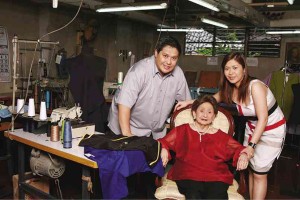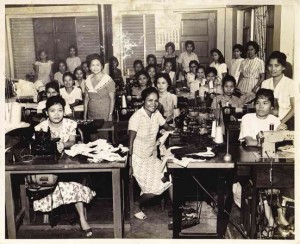The uniform advantage

While parents go all agog over school uniforms only in the months of May and June, such is a daily occurrence in the life of Fermin H. Orosa, he who breathes, lives, and dreams school uniforms all year round.
Orosa is the president of Henson Clothing Co., the pioneer in the local school uniform industry established in 1938 by his grandmother, the late Paz Rodriguez Henson.
Operating right now at its peak season, Henson Clothing Co. produces in a day an average of 500 sets of school uniforms, composed of polo shirts, pants, skirts and blouses. Eighty percent of the company’s business comes from school uniforms, while the rest comes from boy’s outer wear and work wear.
Orosa carries on the 75-year-old tradition passed on to him by his grandmother, but he did not accept the reins of the business without so much taking detours and roundabouts first, only to find himself back in the same place where he started helping out in deliveries during summer as a 12-year-old boy.
“I did not want to work for and with the company. My grandmother was running everything and I thought then that there was nothing else I could do more for the company that supplied ready-to-wear uniforms to every major department store from the ’40s to the mid ’80s in Avenida Rizal in downtown Manila, Divisoria, Carriedo, Binondo, Quiapo, Cubao, and Makati,” recalls Orosa.

True enough, Henson Clothing Co. was lording it over the local school uniform industry that it pioneered in—until progress happened and preferences changed. The retail landscape totally transformed in the mid ’80s when SM Shoemart began building the first of its chain of malls (SM North Edsa) and people started flocking to these one-stop-shops that house everything. One by one, the erstwhile reliable outlets for Henson uniforms, such as the department stores that lined Rizal Avenue in the Sta. Cruz district of Manila, or those in Cubao, folded up. Furthermore, the malls offered a new business model where suppliers would become consignors instead.
‘’Things started to change around us. My lola pulled out the children’s wear line from SM, natira na lang yung sa Divisoria. Furthermore, children started deciding for themselves when it came to their clothes. Whereas before, parents would choose the polo and pants terno, children began preferring cotton knits and T-shirts,” Orosa observes.
Mrs. Henson was not one to ride the waves of change. She was even offered to be a locator in the export processing zone in the ’80s but she also refused this opportunity, saying this was not her ballgame at all. She was apparently satisfied with running her business from their Sampaloc, Manila atelier.
All these missed opportunities frustrated Orosa, a graduate from the University of the Philippines, so he decided to work for other companies as well as put up his own trading company just so he could make decisions on his own.
Yet, the call of family duty made him officially join the company in 1989. He wanted to instill changes but realized shortly that his hands were helplessly tied, he explains.
“Malls were being built here and there and Lola didn’t want to follow. She believed since things worked out for the company for the longest time, the lucky streak would continue through the years to come,” says Orosa who could only watch the company dwindle down in terms of revenues and production. The only thing going for the company was the equity of the trusted brand name Henson.
Bleeding to thriving

In 2001, Mrs. Henson, then already 94 years old, finally acknowledged that she needed help from her family to run the business. Granddaughter Christine Orosa is a Clothing Technology graduate from UP and had already been doing her share to beef up the company’s production unit. It was on the business side that Mrs. Henson needed help with and Fermin was just more than willing to step in.
“We got a consultant who confirmed that the company was bleeding and recommended to close the company. Lola cried, she asked us ’Isara niyo na lang kapag wala na ko yan, lang ang iiwan ko sa inyo,’” Orosa recalls.
The grandkids did not have the heart to have their dear grandmother witness her life’s work perish before her eyes and so they worked together to bring Henson Clothing Co. back to life. Another brother, Manny, took over the accounting duties but Fermin had the most difficut tasks to bear.
“It became a leadership call. I had to talk to the people and offered retirement to some who had been with Lola for years. We had to reorganize and watch the bottomline at the same time,” says Orosa, whose management skills had been further honed after clinching a master’s degree in Entrepreneurship from the Asian Institute of Management.
In 2003, the company also started to venture into work wear, particularly for the medical and hospitality industries. They began to suit up the employees of top hotels and resorts. They also started bagging contracts from several exclusive schools that assured them of stable orders throughout production cycles.
Henson Clothing Co. also pioneered in the use of anti microbial material called Microbe Protech for its uniforms specially made for specific schools.
Slowly systems were put in place and things turned around for the company, so much so that when Lola Paz passed away in 2008 at the age of 101 years old, she quietly slipped away knowing that the company she poured her heart and soul into would be safe in the hands of her grandkids.

Tough industry
Today, Henson Clothing Co. is once again at the top of its game. Orosa says it is mainly because it is clear to them what their niche market is.
“We know where we are, we know what league we are playing. About 80 percent of what we do are school uniforms where most of the revenues come from even if the margins are small. We’d like to beef up the boys outer wear and work wear which at present have a low volume but higher margins,” Orosa says.
They have also hurdled challenges here and there, including competition from the influx of ready-to-wear uniforms from China, and a fire that gutted their factory in 2009.
“It is also in the details, details, details in all aspects of the business. Even if these are generic uniforms, the ultimate objective is still customer satisfaction, ” Orosa says.
Having seen what works and what does not as far as succession in a family corporation is concerned, this third generation uniform maker advised parents to encourage their children to join the family business, but never to require them. It would also help young people, on the other hand, if they first work outside the company and gain a different perspective from being employed.
” Be an apprentice and learn from the world outside, learn from how other people run their businesses professionally. Get into employment to learn, not just to earn, and then consider entrepreneurship, ” Orosa urges.
